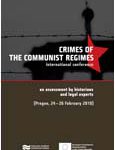The Crimes of the communist regime in Hungary, national report
The Crimes of the communist regime in Hungary, national report
Author(s): János Rainer M.
Subject(s): Politics, Media studies, Human Rights and Humanitarian Law, Civil Society, Recent History (1900 till today), Government/Political systems, History of Communism
Published by: Ústav pro studium totalitních režimů
Summary/Abstract: The expression communist regime refers in this report to the Soviet-type system of rule installed in Hungary after WWII, which persisted until the democratic transformation of 1989–90. Historians attach various terms to this system and this period, and there are a number of incompatible frames for discussing events associated with them. János Kornai, for example, calls it the socialist system and lists as its most general attributes a one-party political system, a monopoly for Marxist-Leninist political ideology, predominance of state or quasi-state ownership, bureaucratic coordination, and a centralized command economy. In the 1950s the Soviet-type system (following Hannah Arendt, Zbigniew Brzezinski and Carl Friedrich) was frequently classed among the totalitarian systems, with chiliastic ideology, a single mass party headed by the dictator, state terror, a monopoly of mass communications, and a centralized planned economy as its main attributes. These translate into institutions and /or patterns of conduct. The institutions altered little over the history of the Soviet-type systems, but there was much change in their methods of working, social embeddedness, interactions, approach to the subjugated, social autonomies and individual strategies. But there also exists a concept of the Soviet-type system – particularly that of the post-Stalinist period – as latent pluralism, exemplified by the Western revisionism that flourished in the 1960s. Others see continuity with the efforts of the Russians (or the Chinese in an Asian variant) to build and maintain an empire. A few claim it to be an alternative to the West European/Atlantic form of modernity, or a kind of catch-up modernization dictatorship that reflects that.
- Page Range: 157-192
- Page Count: 36
- Publication Year: 2011
- Language: English
- Content File-PDF

